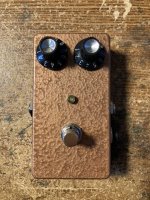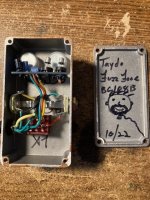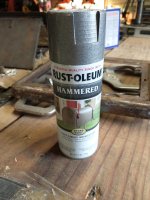Coda
Well-known member
Built this one yesterday: its a Fuzz Face PCB from Tayda. First, a story: a month or so ago, a friend of mine came over with his Hartman BC108 Silicon Fuzz. He bought it about a dozen years ago, and was never too impressed. I was entering my seasonal Fuzz Face phase, and wanted to shoot the Hartman out with my BC109 Sunface (they were nearly identical). The next day I was itchin' for a BC108 Fuzz Face...well, a new one. My first ever build was the Twin Face. I concentrated on the Ge side mainly, and the Si side never really sounded that good (I knew nothing of Hfe, Ge were bought measured from Pedalhacker).
I breadboarded this a week ago. It was...interesting. I started with the schematic Tayda provides with the PCB. It was definitely a schematic. Firstly, the only schematic provided is for PNP. All it says for Si is to swap the electrolytics. It also had a 470R in at R3, and a 50k trimmer for the bias. This was hilarious: the only useable tone was to the extreme of the trimpot, and it was cleaner than it should be. I ended up with a 680R at R3, and a 10k trimmer for the bias. Much better. Once it was assembled (Tayda pre-drill) I wired it up, and added a 47p cap from Q1's collector to base (cures oscillation). Paint is from a can; hammered bronze. It turned out pretty good...
It sounds like a BC108 Fuzz Face: a bit fizzy, a bit raw, both thin and thick at the same time. Cleans up pretty well (as well as it needs to, anyway). The only issue, which I knew going in, is that this pedal does NOT like being on my board. By itself its excellent. On the board its dark, muddy, and doesn't really clean up at all. Oh well...
I think I'm gonna add a battery snap...
I breadboarded this a week ago. It was...interesting. I started with the schematic Tayda provides with the PCB. It was definitely a schematic. Firstly, the only schematic provided is for PNP. All it says for Si is to swap the electrolytics. It also had a 470R in at R3, and a 50k trimmer for the bias. This was hilarious: the only useable tone was to the extreme of the trimpot, and it was cleaner than it should be. I ended up with a 680R at R3, and a 10k trimmer for the bias. Much better. Once it was assembled (Tayda pre-drill) I wired it up, and added a 47p cap from Q1's collector to base (cures oscillation). Paint is from a can; hammered bronze. It turned out pretty good...
It sounds like a BC108 Fuzz Face: a bit fizzy, a bit raw, both thin and thick at the same time. Cleans up pretty well (as well as it needs to, anyway). The only issue, which I knew going in, is that this pedal does NOT like being on my board. By itself its excellent. On the board its dark, muddy, and doesn't really clean up at all. Oh well...
I think I'm gonna add a battery snap...
Attachments
Last edited:




